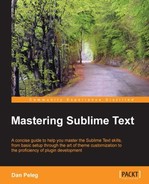Python offers us unittest, an official unit testing framework for Python, sometimes referred as PyUnit. It's like a Python version of JUnit for Java and written by Kent Beck and Erich Gamma.
Tip
For more information on how to use unittest, visit: http://docs.python.org/2/library/unittest.html
Currently the best package that helps us write Python unit tests is called sublime-unittest written by Samuel Martin, which can be found at https://github.com/martinsam/sublime-unittest.
Python's unittest for Sublime is a package that contains a number of useful snippets to ease our unittest writing. To install the package, we'll use Package Control. Let's open the command palette by pressing Ctrl + Shift + P in Windows or Linux and Command + Shift + P in OS X. Then choose Install Package and install the Unittest (python) package.
The installed package has two main snippets:
- testclass: This will create a new test class for us to fill out
class [Foo]TestCase(unittest.TestCase): …
- testfunc: This will create a new test function for us to fill out
def test_[foo](self): …
After creating a test function, we'll need to use some assertions, which the package includes and also the following assertions snippets:
|
Snippet |
Function |
Checks that |
|---|---|---|
|
asse |
|
|
|
assne |
|
|
|
asst |
|
|
|
assf |
|
|
|
assis |
|
|
|
assisnt |
|
|
|
assisne |
|
|
|
assisntne |
|
|
|
assin |
|
|
|
assnin |
|
|
|
assisins |
|
|
|
assnisins |
|
|
Let's try creating a new Test class using our snippets, starting with writing testclass and pressing Tab to insert the snippet. We'll call our TestSequenceFunctions class. We'll also create a test function called test_shuffle using the testfunc snippet, as shown in the following screenshot:

When inserting a snippet, we will get the preceding autocomplete window. Pressing Tab will insert the snippet.
import random
import unittest
class TestSequenceFunctions(unittest.TestCase):
def setUp(self):
self.sequence = range(30)
def test_shuffle(self):
# checks that the shuffled sequence doesn't lose any elements while shuffling and sorting
random.shuffle(self.sequence)
self.sequence.sort()
self.assertEqual(self.sequence, range(30), msg="Elements missing")
if __name__ == '__main__':
unittest.main()When this code is executed, the setUp function is the first to be called and will initialize our sequence. After that, it will start to run all the test functions and assert if something goes wrong. The test functions test_shuffle or random.shuffle(self.sequence) will shuffle our sequence randomly, and then self.sequence.sort() will sort it back. Afterwards, we check if our sorted sequence is equal to range(30), which returns a sorted sequence from 0 to 30. If something went wrong and the sequence doesn't equal the range of 0 to 30, then this test will fail with a message of Elements missing.
We can run this code as we run every Python code:
C:UsersDanpeDesktop>python sample.py . --------------------------------------------------------------- Ran 1 test in 0.000s OK
The preceding is the result of a successful run of our test.
